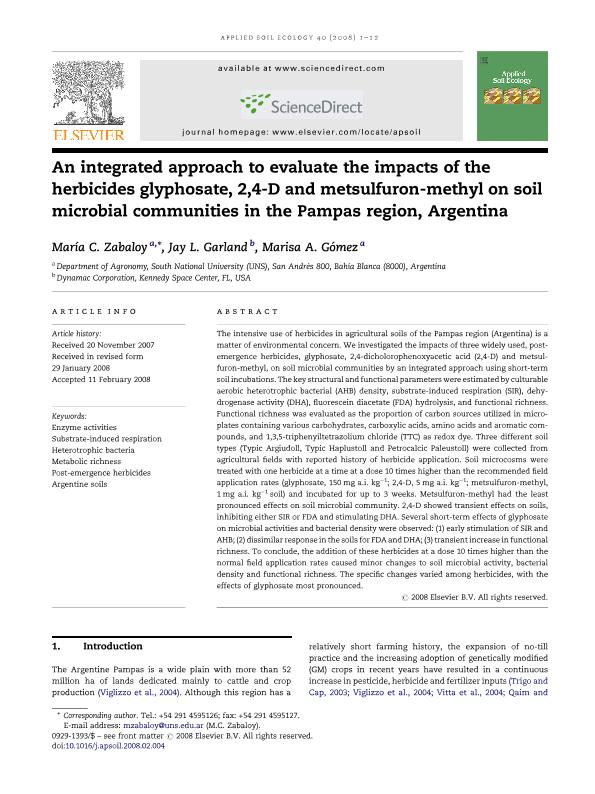Artículo
An integrated approach to evaluate the impacts of the herbicides glyphosate, 2,4-D and metsulfuron-methyl on soil microbial communities in the Pampas region, Argentina
Fecha de publicación:
09/2008
Editorial:
Elsevier Science
Revista:
Applied Soil Ecology
ISSN:
0929-1393
Idioma:
Inglés
Tipo de recurso:
Artículo publicado
Clasificación temática:
Resumen
The intensive use of herbicides in agricultural soils of the Pampas region (Argentina) is a matter of environmental concern. We investigated the impacts of three widely used, post-emergence herbicides, glyphosate, 2,4-dicholorophenoxyacetic acid (2,4-D) and metsulfuron-methyl, on soil microbial communities by an integrated approach using short-term soil incubations. The key structural and functional parameters were estimated by culturable aerobic heterotrophic bacterial (AHB) density, substrate-induced respiration (SIR), dehydrogenase activity (DHA), fluorescein diacetate (FDA) hydrolysis, and functional richness. Functional richness was evaluated as the proportion of carbon sources utilized in microplates containing various carbohydrates, carboxylic acids, amino acids and aromatic compounds, and 1,3,5-triphenyiltetrazolium chloride (TTC) as redox dye. Three different soil types (Typic Argiudoll, Typic Haplustoll and Petrocalcic Paleustoll) were collected from agricultural fields with reported history of herbicide application. Soil microcosms were treated with one herbicide at a time at a dose 10 times higher than the recommended field application rates (glyphosate, 150 mg a.i. kg-1; 2,4-D, 5 mg a.i. kg-1; metsulfuron-methyl, 1 mg a.i. kg-1 soil) and incubated for up to 3 weeks. Metsulfuron-methyl had the least pronounced effects on soil microbial community. 2,4-D showed transient effects on soils, inhibiting either SIR or FDA and stimulating DHA. Several short-term effects of glyphosate on microbial activities and bacterial density were observed: (1) early stimulation of SIR and AHB; (2) dissimilar response in the soils for FDA and DHA; (3) transient increase in functional richness. To conclude, the addition of these herbicides at a dose 10 times higher than the normal field application rates caused minor changes to soil microbial activity, bacterial density and functional richness. The specific changes varied among herbicides, with the effects of glyphosate most pronounced.
Archivos asociados
Licencia
Identificadores
Colecciones
Articulos(CERZOS)
Articulos de CENTRO REC.NAT.RENOVABLES DE ZONA SEMIARIDA(I)
Articulos de CENTRO REC.NAT.RENOVABLES DE ZONA SEMIARIDA(I)
Citación
Zabaloy, Maria Celina; Garland, Jay L.; Gomez, Marisa Anahi; An integrated approach to evaluate the impacts of the herbicides glyphosate, 2,4-D and metsulfuron-methyl on soil microbial communities in the Pampas region, Argentina; Elsevier Science; Applied Soil Ecology; 40; 1; 9-2008; 1-12
Compartir
Altmétricas




